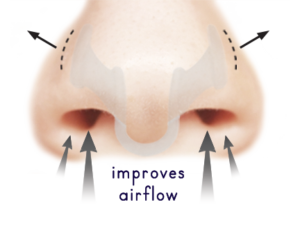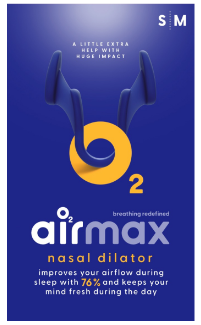AIRMAX™ Snoring Nasal Device (Nasal Dilator)
amx-snoringdeviceDESCRIPTION
The AIRMAX™ Snoring Nasal Device, from the makers of Mack’s®, is a specially designed nasal device that helps users breathe more freely through their nose. It is:
- A simple solution for individuals who have sleeping and breathing difficulties
- Designed to be comfortably placed inside the nasal passages – its patented, aerodynamic “winged” design is clinically proven to help improve airflow by expanding the nasal passages
- Clinically proven to help reduce snoring and mild sleep apnea, and to relieve nasal congestion
- A patented design
- An FDA registered medical device made of hypoallergenic, medical grade material that is soft, flexible and comfortable
- More effective than Breathe Right® Nasal Strips
- Comes with medium AND small, and includes carrying case
Benefits
The AIRMAX™ Snoring Nasal Device helps with various conditions. Below is an overview of the conditions for which it can offer relief:
Snoring
AIRMAX™ is an example of a non-surgical, non-invasive treatment for snoring. Its efficacy has been proven in clinical studies.The sound of snoring is sometimes so strong that a partner, family or in some cases even the neighbors suffer from its effects. Snoring* is created by a restriction in the airway. It is caused by vibrations of the soft palate and other tissue in the mouth, nose and throat (upper airway). It is caused by turbulence inside the airway during inspiration. The turbulence is caused by a partial blockage that may be located anywhere from the tip of the nose to the vocal chords.Twenty percent of all adults are chronic snorers, and 45% of normal adults snore occasionally. As people grow older, their chance of snoring increases. Approximately half of all individuals over 60 snore regularly.The following are possible causes of snoring:
- Sleeping position (on the back)
- Narrowing of the nasal cavity
- Blocked nose due to a cold, allergies, etc.
- Collapsing nostrils
- Fatigue
- Alcohol and Sleeping pills
- Smoking
- Overeating and lack of exercise
Sleep Apnea
AIRMAX™ can help in cases of light sleep apnea/OSA and it can be used in combination with an oxygen mask (e.g. CPAP) and has been proven to increase compliance for CPAP users. AIRMAX™ efficacy has been proven in clinical studies.
Obstructive sleep apnea* (OSA) is a condition that causes interrupted breathing during sleep. The muscles and soft tissues in the throat relax and collapse sufficiently to cause a total blockage of the airway; it is called an apnea when the airflow is blocked for 10 seconds or more. The term ‘obstructive’ distinguishes OSA from rarer forms of sleep apnea, such as central sleep apnea, which is caused by the brain ‘forgetting’ to breathe during sleep. Sleep apnea is associated with being overweight, and other risk factors.
Sleep is driven by natural brain activity. You need to have a certain amount of deep sleep for your body and mind to be fully refreshed. Having only limited episodes of deep sleep will leave you feeling very tired the next day. During the night, people with OSA may experience repeated episodes of apnea. During an episode, lack of oxygen causes the person to come out of deep sleep and into a lighter state of sleep, or a brief period of wakefulness, in order to restore normal breathing. However, after falling back into deep sleep, further episodes of apnea can occur. Such events may occur more than once a minute throughout the night.
Most people with OSA snore loudly. Their breathing may be noisy and labored and is often interrupted by gasping and snorting with each episode of apnea. The repeated interruptions to sleep caused by OSA can make the person feel very tired during the day. A person with OSA will usually have no memory of breathlessness, so they are often unaware that they are not getting a proper night’s sleep.
* Source: National Health Service (NHS), United Kingdom
Nasal congestion
While many people think that a nose gets congested* (stuffy) from too much thick mucus, in most cases, the nose becomes congested when the tissues lining it become swollen. The swelling is due to inflamed blood vessels. Significant congestion may interfere with sleep.AIRMAX™ helps patients suffering from nasal congestion to breathe more freely through the nose. Its efficacy has been proven in clinical studies.
A stuffy nose is usually caused by a virus or bacteria. Causes include:
- Common cold
- Flu
- Sinus infection
The congestion typically goes away by itself within a week.
Congestion also can be caused by:
- Hay fever or other allergies
- Use of some nasal sprays or drops for more than 3 days (may make nasal stuffiness worse)
- Nasal polyps
- Pregnancy
- Vasomotor rhinitis
Instructions for Use
Clean the device with water before and after use. When using AIRMAX™ for the first time, we recommend the use of a mirror to help you position the device. The AIRMAX™ device is properly positioned when the “legs” widen the nasal entrance and when the “connecting bridge” is touching your nasal septum. Refer to illustration below.

You should use the AIRMAX™ device each night for at least 2 consecutive weeks, as it may take time for your nose to become accustomed to the shape of the AIRMAX™ device.
Cleaning Instructions
The AIRMAX™ device can be cleaned with water and mild soap. Each AIRMAX™ device should only be used by one person to prevent transfer of diseases like the common cold.
If you have trouble placing the AIRMAX™ device in your nose because your nose is not symmetrical, you should not use it.
Caution
If, after placement of device, you do not notice improvement in breathing, we advise you seek the advice of an Ear, Nose and Throat (ENT) doctor.
If, after regular use of the AIRMAX™ device, your nasal passages become irritated, this could be an allergic reaction to the medical grade plastic. Discontinue use and see a physician if condition persists. To date, no allergic reactions have been reported.
AIRMAX™ is not suitable for children under the age of 12. Keep out of reach of younger children to prevent choking.













